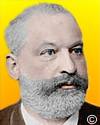 (source)
(source)
|
Clemens Alexander Winkler
(26 Dec 1838 - 8 Oct 1904)
German chemist who, in 1886, discovered a new element in the mineral argyodite, which he named germanium, for Germany.
|
Winkler and the Discovery of Germanium
From The Discovery of the Elements
by Mary Elvira Weeks (1934)
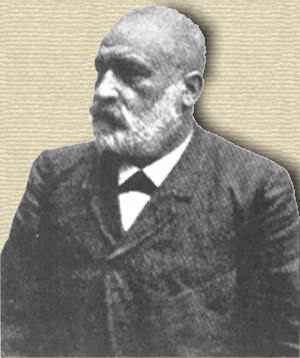
1838-1904
[p.223] A third element that Mendeléeff had predicted was to be a member of the silicon family. This “ekasilicon was discovered in 1886 by Clemens Winkler, who named it germanium in honor of his fatherland. Thus the three “nationalist” elements—gallium in France, scandium in Sweden, and germanium in Germany—were all discovered within fifteen years after their prediction by the great Russian chemist. Although Mendeléeff was the first person to describe the properties of ekasilicon, the gap in the periodic table had been observed about seven years before by the English chemist, Newlands, who had noticed that silicon and tin form the extremities of a triad, the middle member of which was missing.
Clemens Alexander Winkler was born at Freiberg on December 26, 1838, but grew up in Zschopenthal, a village in the Saxon Erzgebirge where his father, Kurt Alexander Winkler, operated a smalt works. Kurt Winkler was himself a well-known chemist and metallurgist, who had studied under Berzelius and Sefström, and had fitted up an excellent metallurgical laboratory in the small works.
Since the son soon learned to love Nature, his father taught him to identify and classify plants, animals, and minerals. The boy, however, never acquired a passion for collecting. He wanted to learn as much as possible about each specimen, but had no desire to own it. At the age of twelve years he entered the Freiberg gymnasium, where he studied mineralogy under August Breithaupt. Winkler did not like foreign languages, but nevertheless acquired such a thorough mastery of his mother tongue that his scientific papers are valued not only for their genuine scientific merit but also for their beautiful, faultless German.
[p.224] He continued his education at the Realschule, or scientific school, at Dresden and at the Gewerbeschule, or technical school, in Chemnitz, spending the vacations in his father's laboratory. When he entered the Freiberg School of Mines in 1857, he already knew more analytical chemistry than was taught there, and because of this thorough preparation and his sound constitution, he was able to make remarkable progress in research without missing any of the dances and gay parties so dear to a student's heart.
His paper on the reactions that take place in the Gay-Lussac towers of sulfuric acid plants resulted from his successful experiments on the absorption of obnoxious sulfur dioxide fumes from an ultramarine plant. In order to analyze the gases, he invented the Winkler gas buret with a three-way stopcock, and perfected his own methods. In the meantime he made his living by producing nickel and cobalt on a commercial scale.
In 1873 he accepted a position as professor of chemical technology and analytical chemistry at Freiberg. G. D. Hinrichs once said, “The perfection of the analytical work of Winkler astonished me till I found the name of his father, Kurt Winkler, in the list of special students of Berzelius”. Winkler, who had learned neatness from his father, soon transformed the slovenly laboratories, and trained his students to work so carefully that rubber aprons were not needed. One day, when a new student appeared, [p.225] wearing a large apron, Winkler exclaimed, “And so you're going to mix lime.”
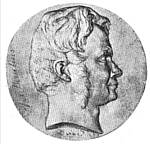
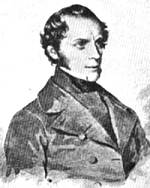
1787-1845
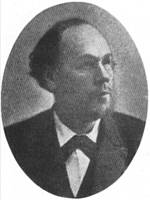
1833-1901
In the fall of 1885 there was found, at the approach of a vein in the Himmelsfürst mine near Freiberg, a new ore which the discoverer, Albin Weisbach, a professor of mineralogy at the Freiberg School of Mines, named argyrodite. Hieronymus Theodor Richter, the chemist who with Ferdinand Reich had discovered indium, made a qualitative blowpipe analysis of the argyrodite, and found that it contained silver, sulfur, and a trace of mercury. Professor Weisbach then asked Winkler to make a thorough quantitative analysis in order to establish the composition of the mineral. Winkler's results were consistent, but, since they invariably came out 7% too low, he concluded that the ore must contain an unknown element.
Believing that the mineral must be a sulfo salt of silver and that the new element must belong in the same analytical group with arsenic, antimony, and tin, he fused a pulverized portion with sodium carbonate and sulfur, took up the melt with water, and filtered off the residue. By making the filtrate slightly acidic with hydrochloric acid, he precipitated and removed the sulfides of arsenic and antimony. Now, since the new element had not been removed with any of the precipitates, it would have to be present in the filtrate as a sodium sulfo salt. Yet when Winkler added a little more hydrochloric acid, a precipitate containing free sulfur, but no sulfide, was thrown down. Even upon evaporating the filtrate to dryness, he obtained nothing but sodium chloride.
Unwilling to submit to this failure, Winkler toiled incessantly for four months, thinking constantly of the elusive element. On February 6, 1886, he filtered off the precipitated sulfur as he had done so many times before and, reckless with discouragement, poured into the clear filtrate a [p.226] large quantity of hydrochloric acid. To his great delight a heavy, flaky, white precipitate immediately appeared. This substance, the sulfide of the new element, dissolved readily in ammonium hydroxide, and precipitated again upon addition of a large excess of hydrochloric acid, for it has a most surprising property: it is quite insoluble in concentrated acids, yet readily soluble in water and dilute acids.
The new element, which he called germanium, was isolated by heating the dry sulfide in a current of hydrogen. The gray, metallic powder was found to be less volatile than antimony, but the volatility of the chloride explains why Winkler obtained nothing but sodium chloride when he evaporated the filtrate from the precipitated sulfur. The germanium chloride had all been lost as vapor. The ore argyrodite is now known to be a double sulfide of silver and germanium, GeS2·4Ag2S.
Winkler thought at first that germanium was a metalloid like antimony and arsenic, and that it would be found to be identical with Mendeléeff's predicted ekastibium, an element which ought to lie between antimony and bismuth. The scientific world immediately became interested in the new element. On February 26th Mendeleeff contributed to the Berichte der deutschen chemischen Gesellschaft a list of properties which the new element would have to have in order to fit into the space between antimony and bismuth. He thought it more likely, however, because of the solubility of the chloride in water and because of the white color of the sulfide, that germanium was ekacadmium, an element between cadmium and mercury. At the same time Victor von Richter of Breslau wrote to Winkler saying he believed germanium to be ekasilicon, the lowest homolog of tin, an undiscovered element between gallium and arsenic. Two days later Lothar Meyer said in the Berichte that he, too, believed germanium to be the longed-for ekasilicon, and that he had already expressed that opinion to his advanced students .
[p.227] Winkler's months of discouragement were ended, and he worked joyously, stimulated by the interest and encouragement of these eminent chemists. A vast amount of work remained to be done, and the obtaining of sufficient quantities of germanium compounds became increasingly difficult. Pure argyrodite contains only 7 per cent. of germanium, the rich ore had been exhausted, and Winkler was obliged to work up large quantities of the low-grade ore. He had at first hoped to strike richer deposits of argyrodite, and had therefore been too generous with his valuable germanium compounds. Nevertheless, he finally obtained convincing proof that germanium is the ekasilicon predicted by Mendeléeff in 1871 [by comparing the predicted properties of ekasilicon with the actual properties of germanium].
Mendeléeff had made only one mistake in his prophecy. He had thought that ekasilicon, like titanium, would be difficult to liquefy and volatilize. Lothar Meyer, who had disagreed with him on this point, proved to be correct. Winkler afterward said that germanium contradicted all expectations in its occurrence in nature. He said that he might have expected to find it combined with oxygen and accompanied by titanium and zirconium in rare Scandinavian minerals, but would never have thought to look for it in silver mines among the related compounds of arsenic and antimony.
Clemens Winkler made brilliant contributions both to pure and applied chemistry, and had many interests beyond the chemical field. Like Davy and Ekeberg, he had poetic ability, and many of his songs are preserved in the songbook of the Freiberg Academy. O. Brunck says that these were written in good form and with well-chosen words. For the entertainment of his guests, Winkler often used to write humorous chemical verses for them to sing while he played a gay accompaniment on almost any instrument they might prefer. He resigned his professorship in 1902, and died of carcinoma on October 8, 1904. His name will always be honored wherever true scientific greatness is appreciated.
- Science Quotes by Clemens Alexander Winkler.
- 26 Dec - short biography, births, deaths and events on date of Winkler's birth.
- Discovery of the Elements, by Mary Elvira Weeks. - book suggestion.




